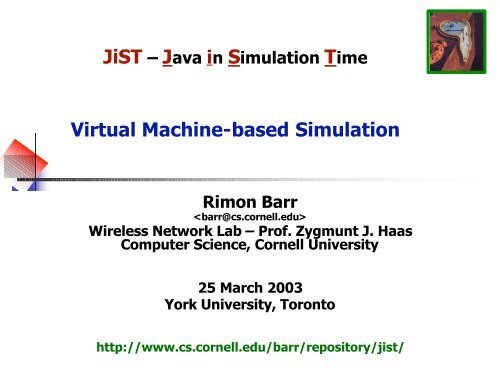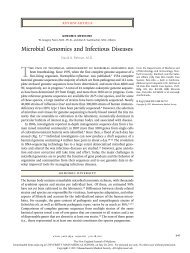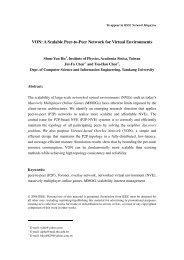JiST – Java in Simulation Time - Evernote
JiST – Java in Simulation Time - Evernote
JiST – Java in Simulation Time - Evernote
You also want an ePaper? Increase the reach of your titles
YUMPU automatically turns print PDFs into web optimized ePapers that Google loves.
<strong>JiST</strong> <strong>–</strong> <strong>Java</strong> <strong>in</strong> <strong>Simulation</strong> <strong>Time</strong><br />
Virtual Mach<strong>in</strong>e-based <strong>Simulation</strong><br />
Rimon Barr<br />
<br />
Wireless Network Lab <strong>–</strong> Prof. Zygmunt J. Haas<br />
Computer Science, Cornell University<br />
25 March 2003<br />
York University, Toronto<br />
http://www.cs.cornell.edu/barr/repository/jist/
motivation: wireless networks<br />
• discrete event simulators are useful and needed<br />
• <strong>in</strong> physics, biology, f<strong>in</strong>ance, meteorology, etc.<br />
• e.g., wireless networks<br />
• published ad hoc network simulations<br />
<strong>JiST</strong> <strong>–</strong> <strong>Java</strong> <strong>in</strong> <strong>Simulation</strong> <strong>Time</strong><br />
• lack network size - ~500 nodes; or<br />
• compromise detail - packet level; or<br />
• curtail duration - few m<strong>in</strong>utes; or<br />
• are of sparse density -
what is a simulation?<br />
• unstructured simulation: computers compute<br />
• time structured: event-oriented vs. process-oriented<br />
• discrete event simulator is a program that:<br />
• encodes the simulation model<br />
• stores the state of the simulated world<br />
• performs events at discrete simulation times<br />
• loops through a temporally ordered event queue<br />
• works through simulation time as quickly as possible<br />
• desirable properties of a simulator:<br />
• correctness - valid simulation results<br />
• efficiency - performance <strong>in</strong> terms of throughput and memory<br />
• transparency - separate correctness from efficiency:<br />
- write “simple” program <strong>in</strong> a standard language<br />
- provide implicit optimization, concurrency,<br />
distribution, portability, etc.<br />
<strong>JiST</strong> <strong>–</strong> <strong>Java</strong> <strong>in</strong> <strong>Simulation</strong> <strong>Time</strong><br />
3
how do we build simulators?<br />
<strong>JiST</strong> <strong>–</strong> <strong>Java</strong> <strong>in</strong> <strong>Simulation</strong> <strong>Time</strong><br />
systems<br />
• simulation kernels<br />
• control schedul<strong>in</strong>g, IPC, clock<br />
• processes run <strong>in</strong> virtual time<br />
• e.g. <strong>Time</strong>Warp OS, Warped<br />
transparency efficiency<br />
• simulation libraries<br />
• move functionality to user-space<br />
for performance; monolithic prog.<br />
• usually event-oriented<br />
• e.g. Yansl, Compose, ns2<br />
transparency efficiency<br />
virtual mach<strong>in</strong>es<br />
languages<br />
• generic simulation languages<br />
• <strong>in</strong>troduce entities, messages<br />
and simulation time semantics<br />
• event and state constra<strong>in</strong>ts<br />
allow optimization<br />
• both event and process oriented<br />
• e.g. Simula, Parsec/GloMoSim<br />
• application-specific languages<br />
• e.g. Apostle, TeD<br />
transparency efficiency<br />
new language<br />
4
the jist approach<br />
• <strong>JiST</strong> <strong>–</strong> <strong>Java</strong> <strong>in</strong> <strong>Simulation</strong> <strong>Time</strong><br />
• converts a virtual mach<strong>in</strong>e <strong>in</strong>to a simulation platform<br />
• no new language, no new library, no new runtime<br />
• merges modern language and simulation semantics<br />
<strong>JiST</strong> <strong>–</strong> <strong>Java</strong> <strong>in</strong> <strong>Simulation</strong> <strong>Time</strong><br />
• comb<strong>in</strong>es systems-based and languages-based approaches<br />
• result: virtual mach<strong>in</strong>e-based simulation<br />
5
system architecture<br />
1. Compile simulation with standard <strong>Java</strong> compiler<br />
2. Run simulation with<strong>in</strong> <strong>JiST</strong> (with<strong>in</strong> <strong>Java</strong>); simulation classes are<br />
dynamically rewritten to <strong>in</strong>troduce simulation time semantics:<br />
• extend the <strong>Java</strong> object model and execution model<br />
• <strong>in</strong>structions take zero (simulation) time<br />
• time explicitly advanced by the program: sleep(time)<br />
• progress of time is dependent on program progress<br />
3. Rewritten program <strong>in</strong>teracts with simulation kernel<br />
<strong>JiST</strong> <strong>–</strong> <strong>Java</strong> <strong>in</strong> <strong>Simulation</strong> <strong>Time</strong><br />
6
jist object model<br />
• program state conta<strong>in</strong>ed <strong>in</strong> objects<br />
• objects conta<strong>in</strong>ed <strong>in</strong> entities<br />
• th<strong>in</strong>k of an entity as a simulation component<br />
• an entity is any class tagged with the Entity <strong>in</strong>terface<br />
• each entity runs at its own simulation time<br />
• as with objects, entities do not share state<br />
• ak<strong>in</strong> to a JKernel process <strong>in</strong> spirit, but without the threads!<br />
<strong>JiST</strong> <strong>–</strong> <strong>Java</strong> <strong>in</strong> <strong>Simulation</strong> <strong>Time</strong><br />
7
jist execution model<br />
• entity methods are an event <strong>in</strong>terface<br />
• simulation time <strong>in</strong>vocation<br />
• non-block<strong>in</strong>g; <strong>in</strong>voked at caller entity time; no cont<strong>in</strong>uation<br />
• like co-rout<strong>in</strong>es, but scheduled <strong>in</strong> simulation time<br />
• entity references replaced with separators<br />
• event channels; act as state-time boundary<br />
• demarcate a <strong>Time</strong>Warp-like process, but at f<strong>in</strong>er granularity<br />
<strong>JiST</strong> <strong>–</strong> <strong>Java</strong> <strong>in</strong> <strong>Simulation</strong> <strong>Time</strong><br />
8
a basic example<br />
• the “hello world” of event simulations<br />
<strong>JiST</strong> <strong>–</strong> <strong>Java</strong> <strong>in</strong> <strong>Simulation</strong> <strong>Time</strong><br />
class HelloWorld implements JistAPI.Entity<br />
{<br />
public void hello()<br />
{<br />
JistAPI.sleep(1);<br />
hello();<br />
System.out.pr<strong>in</strong>tln("hello world, " +<br />
"time=" + JistAPI.get<strong>Time</strong>() );<br />
}<br />
}<br />
• demo!<br />
<strong>Java</strong><br />
Stack overflow @hello<br />
<strong>JiST</strong><br />
hello world, time=1<br />
hello world, time=2<br />
hello world, time=3<br />
etc.<br />
*<br />
9
jist api<br />
• JistAPI class is the <strong>JiST</strong> kernel system call <strong>in</strong>terface<br />
• permits standard <strong>Java</strong> compilation and execution<br />
<strong>JiST</strong> <strong>–</strong> <strong>Java</strong> <strong>in</strong> <strong>Simulation</strong> <strong>Time</strong><br />
// used <strong>in</strong> hello example<br />
<strong>in</strong>terface Entity - tag object as entity<br />
long get<strong>Time</strong>() - return simulation time<br />
void sleep(long ticks) - advance simulation time<br />
// others, to be <strong>in</strong>troduced shortly<br />
<strong>in</strong>terface <strong>Time</strong>less - tag object as timeless<br />
<strong>in</strong>terface Proxiable - tag object as proxiable<br />
Entity proxy(target, <strong>in</strong>tface) - create proxy entity<br />
class Cont<strong>in</strong>uation ext. Error <strong>–</strong> tag method as block<strong>in</strong>g<br />
void run(type,name,args,...) - run program or script<br />
void runAt(Runnable r) - schedule procedure<br />
void endAt(long time) - end simulation<br />
Channel createChannel() - sim. time CSP Channel<br />
void <strong>in</strong>stallRewrite(rewriter) <strong>–</strong> <strong>in</strong>stall transformation<br />
EntityRef THIS - this entity reference<br />
EntityRef ref(Entity e) - get entity reference<br />
// ... and few more<br />
*<br />
10
jist micro-benchmark: event throughput<br />
<strong>JiST</strong> <strong>–</strong> <strong>Java</strong> <strong>in</strong> <strong>Simulation</strong> <strong>Time</strong><br />
5x10^6 events time (sec) vs. reference vs. <strong>JiST</strong><br />
reference 0.74 0.76x<br />
<strong>JiST</strong> 0.97 1.31x<br />
Parsec 1.91 2.59x 1.97x<br />
ns2-C 3.26 4.42x 3.36x<br />
GloMoSim 9.54 12.93x 9.84x<br />
ns2-Tcl 76.56 103.81x 78.97x<br />
11
jist micro-benchmark: memory overhead<br />
<strong>JiST</strong> <strong>–</strong> <strong>Java</strong> <strong>in</strong> <strong>Simulation</strong> <strong>Time</strong><br />
memory per entity per event 10K nodes sim.<br />
<strong>JiST</strong> 36 B 36 B 21 MB<br />
GloMoSim 36 B 64 B 35 MB<br />
ns2 * 544 B 40 B 74 MB<br />
Parsec 28536 B 64 B 2885 MB<br />
12
SWANS<br />
• Scalable Wireless Ad hoc Network Simulator<br />
• similar functionality to ns2 and GloMoSim, but...<br />
• runs standard <strong>Java</strong> network applications over simulated networks<br />
• can simulate networks of 1,000,000 nodes<br />
sequentially, on a s<strong>in</strong>gle commodity uni-processor<br />
• runs on top of <strong>JiST</strong>; SWANS is a <strong>JiST</strong> application<br />
• uses hierarchical b<strong>in</strong>n<strong>in</strong>g for efficient propagation<br />
• component-based architecture written <strong>in</strong> <strong>Java</strong> App<br />
<strong>JiST</strong> <strong>–</strong> <strong>Java</strong> <strong>in</strong> <strong>Simulation</strong> <strong>Time</strong><br />
sim. stack<br />
files<br />
classes<br />
SWANS<br />
<strong>JiST</strong><br />
<strong>Java</strong><br />
l<strong>in</strong>es<br />
semi<br />
<strong>JiST</strong> 29 113 14057 3502<br />
SWANS 85 220 28617 6536<br />
Other 32 80 6939 2509<br />
146 413 49613 12547<br />
13
exist<strong>in</strong>g wireless simulators<br />
ns2 is the gold standard<br />
• written <strong>in</strong> C++ with Tcl b<strong>in</strong>d<strong>in</strong>gs<br />
• created for TCP simulation,<br />
modified for wireless networks<br />
• processor and memory <strong>in</strong>tensive<br />
• sequential; max. ~500 nodes<br />
• recently “fixed” for ~5000 nodes<br />
OpNet <strong>–</strong> popular commercial option<br />
• good model<strong>in</strong>g capabilities<br />
• poor scalability<br />
PDNS <strong>–</strong> parallel distributed ns2<br />
• event loop uses RTI-KIT<br />
• uses fast <strong>in</strong>ter-connect to<br />
distribute memory requirements<br />
• shown ~100,000 nodes<br />
<strong>JiST</strong> <strong>–</strong> <strong>Java</strong> <strong>in</strong> <strong>Simulation</strong> <strong>Time</strong><br />
rule of thumb: extra 10x <strong>in</strong> scale,<br />
us<strong>in</strong>g at least 10x hardware and cost<br />
sequential<br />
GloMoSim<br />
• implemented <strong>in</strong> Parsec, a<br />
custom C-like language<br />
• implements “node aggregation,”<br />
to conserve memory<br />
• shown ~10,000 nodes on NUMA<br />
mach<strong>in</strong>e (SPARC 1000, est. $300k)<br />
custom-made simulators<br />
• fast, specialized computation<br />
• lack sophisticated execution and<br />
also credibility<br />
parallel<br />
SWAN<br />
• parallelized and distributed us<strong>in</strong>g<br />
the DaSSF framework<br />
• similar capabilities to GloMoSim<br />
• shown ~100,000 nodes<br />
14
SWANS components<br />
<strong>JiST</strong> <strong>–</strong> <strong>Java</strong> <strong>in</strong> <strong>Simulation</strong> <strong>Time</strong><br />
function implementation<br />
application - heartbeat;<br />
any <strong>Java</strong> network application<br />
transport - UDP; TCP [Tamtoro]<br />
network - IPv4<br />
rout<strong>in</strong>g - ZRP ; DSR [Viglietta]; AODV [L<strong>in</strong>]<br />
l<strong>in</strong>k - 802.11b ; naïve ; wired<br />
placement - random ; <strong>in</strong>put file<br />
mobility - static; random waypo<strong>in</strong>t; <strong>in</strong>put file<br />
<strong>in</strong>terference - <strong>in</strong>dependent, ns2;<br />
additive , GloMoSim<br />
fad<strong>in</strong>g - zero ; Raleigh ; Rician<br />
pathloss - free-space ; two-ray<br />
propagation<br />
algorithm<br />
- l<strong>in</strong>ear scan , ns2;<br />
flat b<strong>in</strong>n<strong>in</strong>g , GloMoSim;<br />
hierarchical b<strong>in</strong>n<strong>in</strong>g<br />
15
SWANS performance<br />
<strong>JiST</strong> <strong>–</strong> <strong>Java</strong> <strong>in</strong> <strong>Simulation</strong> <strong>Time</strong><br />
• simulation configuration<br />
• application - heartbeat neighbor discovery<br />
• field - 5x5km 2 ; free-space path loss; zero fad<strong>in</strong>g<br />
• mobility - random waypo<strong>in</strong>t: v=2-5m, p=10s<br />
• radio - additive noise; standard power, ga<strong>in</strong>, etc.<br />
• stack - 802.11b, IPv4, UDP<br />
16
SWANS performance<br />
t=15m<br />
nodes time memory time memory time memory time memory<br />
500 7136.3 s 58761 KB 81.6 s 5759 KB 53.5 s 700 KB 43.1 s 1101 KB<br />
5000 6191.4 s 27570 KB 3249.6 s 4887 KB 433.0 s 5284 KB<br />
50000 47717 KB 4377.0 s 49262 KB<br />
<strong>JiST</strong> <strong>–</strong> <strong>Java</strong> <strong>in</strong> <strong>Simulation</strong> <strong>Time</strong><br />
ns2 GloMoSim SWANS SWANS-hier<br />
17
SWANS performance<br />
<strong>JiST</strong> <strong>–</strong> <strong>Java</strong> <strong>in</strong> <strong>Simulation</strong> <strong>Time</strong><br />
t=2m<br />
SWANS-hier<br />
nodes 10,000 100,000 1 million per node<br />
<strong>in</strong>itial memory 13 MB 100 MB 1000 MB 1.0 KB<br />
avg. memory 45 MB 160 MB 1200 MB 1.2 KB<br />
time 2 m 25 m 5.5 h 20 ms<br />
18
performance summary<br />
• SWANS scalability<br />
• can simulate million node wireless networks<br />
• hierarchical b<strong>in</strong>n<strong>in</strong>g allows l<strong>in</strong>ear scal<strong>in</strong>g with network size<br />
• SWANS is a <strong>JiST</strong> application<br />
• a simulation program written us<strong>in</strong>g the “<strong>JiST</strong> approach”<br />
• scalability depends on:<br />
• time <strong>–</strong> efficient simulation event process<strong>in</strong>g<br />
• space <strong>–</strong> efficient simulation state encod<strong>in</strong>g<br />
<strong>JiST</strong> <strong>–</strong> <strong>Java</strong> <strong>in</strong> <strong>Simulation</strong> <strong>Time</strong><br />
19
enefits of the jist approach<br />
• more than just performance…<br />
• application-oriented benefits<br />
• type safety source and target statically checked<br />
• event types not required (implicit)<br />
• event structures not required (implicit)<br />
• debugg<strong>in</strong>g dispatch source location and state available<br />
• language-oriented benefits<br />
• <strong>Java</strong> standard language, compiler, runtime<br />
• garbage collection cleaner code, memory sav<strong>in</strong>gs<br />
• reflection script-based simulation configuration<br />
• safety f<strong>in</strong>e gra<strong>in</strong>ed isolation<br />
• robustness no memory leaks, no crashes<br />
• system-oriented benefits<br />
• IPC no context switch, no serialization, zero-copy<br />
• <strong>Java</strong> kernel cross-layer optimization<br />
• rewrit<strong>in</strong>g no source-code access required<br />
• distribution provides a s<strong>in</strong>gle system image abstraction<br />
• concurrency model supports parallel and speculative execution<br />
• hardware-oriented benefits<br />
• cost COTS hardware and clusters<br />
• portability runs on everyth<strong>in</strong>g<br />
<strong>JiST</strong> <strong>–</strong> <strong>Java</strong> <strong>in</strong> <strong>Simulation</strong> <strong>Time</strong><br />
20
ewriter<br />
• rewriter properties<br />
• dynamic class loader<br />
• no source code access required<br />
• operates on application packages, not system classes<br />
• uses Apache Byte Code Eng<strong>in</strong>eer<strong>in</strong>g Library (BCEL)<br />
• allows orthogonal additions, transformations and optimizations<br />
• rewrit<strong>in</strong>g phases<br />
• application-specific rewrites<br />
• verification<br />
• add entity self reference<br />
• <strong>in</strong>tercept entity state access<br />
• add method stub fields<br />
• <strong>in</strong>tercept entity <strong>in</strong>vocations<br />
• modify entity creation<br />
• modify entity references<br />
• modify typed <strong>in</strong>structions<br />
• cont<strong>in</strong>uable analysis<br />
• cont<strong>in</strong>uation transformation<br />
• translate <strong>JiST</strong> API calls<br />
<strong>JiST</strong> <strong>–</strong> <strong>Java</strong> <strong>in</strong> <strong>Simulation</strong> <strong>Time</strong><br />
21
zero-copy semantics<br />
• timeless object: a temporally stable object<br />
• <strong>in</strong>ferred statically as open-world immutable<br />
• or tagged explicitly with the <strong>Time</strong>less <strong>in</strong>terface<br />
• benefits<br />
• pass-by-reference saves memory copy<br />
• zero-copy semantics for <strong>in</strong>ter-entity communication<br />
• saves memory for common shared objects<br />
<strong>JiST</strong> <strong>–</strong> <strong>Java</strong> <strong>in</strong> <strong>Simulation</strong> <strong>Time</strong><br />
• e.g. broadcast network packets<br />
• rewrite new of common types to hashcons<br />
22
configurability<br />
• configurability is essential for simulators<br />
1. source level reuse; recompilation<br />
2. configuration files read by driver program<br />
3. driver program is a script<strong>in</strong>g language eng<strong>in</strong>e<br />
• support for multiple script<strong>in</strong>g languages by reflection<br />
• no additional code<br />
• no memory overhead<br />
• no performance hit<br />
• Bsh - scripted <strong>Java</strong><br />
Jython - Python<br />
• Smalltalk, Tcl, Ruby,<br />
Scheme and <strong>Java</strong>Script<br />
<strong>JiST</strong> <strong>–</strong> <strong>Java</strong> <strong>in</strong> <strong>Simulation</strong> <strong>Time</strong><br />
23
simulations us<strong>in</strong>g real applications<br />
• us<strong>in</strong>g entity method <strong>in</strong>vocations…<br />
• one can easily write event-driven entities.<br />
• what about process-oriented simulation?<br />
• block<strong>in</strong>g events<br />
• any entity method that “throws” a Cont<strong>in</strong>uation exception<br />
• event process<strong>in</strong>g frozen at <strong>in</strong>vocation<br />
• cont<strong>in</strong>ues after call event<br />
completes, at some later<br />
simulation time<br />
• benefits<br />
• no explicit process<br />
• block<strong>in</strong>g and non-block<strong>in</strong>g coexist<br />
• ak<strong>in</strong> to simulation time thread<strong>in</strong>g<br />
• can build simulated network sockets<br />
• can run standard applications over<br />
these simulated sockets<br />
<strong>JiST</strong> <strong>–</strong> <strong>Java</strong> <strong>in</strong> <strong>Simulation</strong> <strong>Time</strong><br />
*<br />
24
captur<strong>in</strong>g cont<strong>in</strong>uations<br />
• mark entity method as block<strong>in</strong>g: throws Cont<strong>in</strong>uation<br />
• sav<strong>in</strong>g and restor<strong>in</strong>g the stack is non-trivial <strong>in</strong> <strong>Java</strong>!<br />
<strong>JiST</strong> <strong>–</strong> <strong>Java</strong> <strong>in</strong> <strong>Simulation</strong> <strong>Time</strong><br />
25
simulation time concurrency<br />
us<strong>in</strong>g cont<strong>in</strong>uations…<br />
• simulation time Thread<br />
• cooperative concurrency<br />
• can also support pre-emptive, but not necessary<br />
• simulation time concurrency primitives:<br />
• CSP Channel: JistAPI.createChannel()<br />
• locks, semaphores, barriers, monitors, FIFOs, …<br />
<strong>JiST</strong> <strong>–</strong> <strong>Java</strong> <strong>in</strong> <strong>Simulation</strong> <strong>Time</strong><br />
26
ewriter flexibility<br />
• simulation time transformation<br />
• extend <strong>Java</strong> object model with entities<br />
• extend <strong>Java</strong> execution model with events<br />
• language-based simulation kernel<br />
• extensions to the model<br />
• timeless objects: pass-by-reference to avoid copy, saves memory<br />
• reflection: script<strong>in</strong>g, simulation configuration, trac<strong>in</strong>g<br />
• tight event coupl<strong>in</strong>g: cross-layer optimization, debugg<strong>in</strong>g<br />
• proxy entities: <strong>in</strong>terface-based entity def<strong>in</strong>ition<br />
• block<strong>in</strong>g events: call and callback, CPS transformation, standard applications<br />
• simulation time concurrency: Threads, Channels and other synch. primitives<br />
• distribution: location <strong>in</strong>dependence of entities, s<strong>in</strong>gle system image abstraction<br />
• parallelism: concurrent and speculative execution<br />
• orthogonal additions, transformations and optimizations<br />
• platform for simulation research<br />
• e.g. reverse computations <strong>in</strong> optimistic simulation [Carothers ’99]<br />
• e.g. stack-less process oriented simulation [Booth ’97]<br />
<strong>JiST</strong> <strong>–</strong> <strong>Java</strong> <strong>in</strong> <strong>Simulation</strong> <strong>Time</strong><br />
27
summary<br />
• <strong>JiST</strong> <strong>–</strong> <strong>Java</strong> <strong>in</strong> <strong>Simulation</strong> <strong>Time</strong><br />
• converts virtual mach<strong>in</strong>e <strong>in</strong>to simulation platform<br />
• merges systems and language-based approaches<br />
• runs SWANS: Scalable Wireless Ad hoc Network Simulator<br />
• efficient: both <strong>in</strong> terms of throughput and memory<br />
• flexible: timeless objects, reflection-based script<strong>in</strong>g,<br />
tight event coupl<strong>in</strong>g, proxy entities, cont<strong>in</strong>uations and<br />
block<strong>in</strong>g methods, simulation time concurrency,<br />
distribution, concurrency … serve as a research platform<br />
<strong>JiST</strong> <strong>–</strong> <strong>Java</strong> <strong>in</strong> <strong>Simulation</strong> <strong>Time</strong><br />
28
<strong>JiST</strong> <strong>–</strong> <strong>Java</strong> <strong>in</strong> <strong>Simulation</strong> <strong>Time</strong><br />
Virtual Mach<strong>in</strong>e-based <strong>Simulation</strong><br />
THANK YOU.<br />
http://www.cs.cornell.edu/barr/repository/jist/
simulation time<br />
• actual time<br />
• standard <strong>Java</strong> program execution semantics<br />
• progress of program <strong>in</strong>dependent of time<br />
• real time<br />
• need stronger guarantees on progress<br />
• progress of program made dependent on time<br />
• simulation time<br />
• progress of time is dependent on program progress<br />
<strong>JiST</strong> <strong>–</strong> <strong>Java</strong> <strong>in</strong> <strong>Simulation</strong> <strong>Time</strong><br />
• <strong>in</strong>structions take zero (simulation) time<br />
• time explicitly advanced by the program: sleep(time)<br />
• simulation event loop embedded <strong>in</strong> virtual mach<strong>in</strong>e<br />
• rewriter <strong>in</strong>troduces simulation time semantics by<br />
• extend<strong>in</strong>g the <strong>Java</strong> object model<br />
• extend<strong>in</strong>g the <strong>Java</strong> execution model<br />
30
<strong>JiST</strong> features <strong>in</strong> SWANS<br />
• SWANS is a <strong>JiST</strong> application<br />
• entity <strong>in</strong>vocation track<strong>in</strong>g time<br />
<strong>JiST</strong> <strong>–</strong> <strong>Java</strong> <strong>in</strong> <strong>Simulation</strong> <strong>Time</strong><br />
no context switch<strong>in</strong>g; zero-copy; cross-layer optimizations;<br />
type-safety; implicit event structures and types<br />
• timeless objects packets<br />
saves memory; simplifies memory management<br />
• proxy entities network stack<br />
restricts communication pattern; simplifies development<br />
• reflection script-based configuration<br />
no memory or performance hit; no additional code<br />
• cont<strong>in</strong>uations socket implementations<br />
run standard <strong>Java</strong> network applications over simulated network<br />
31
tight event coupl<strong>in</strong>g<br />
• tight coupl<strong>in</strong>g of event dispatch and delivery<br />
provides numerous benefits:<br />
• type safety source and target of event statically<br />
verified by compiler<br />
• event typ<strong>in</strong>g not required; events automatically<br />
type-cast as they are dequeued<br />
• event structures not required; event parameters<br />
automatically marshaled<br />
• debugg<strong>in</strong>g event dispatch location and state<br />
are available<br />
• execution transparently allows for parallel,<br />
optimistic and distributed execution<br />
<strong>JiST</strong> <strong>–</strong> <strong>Java</strong> <strong>in</strong> <strong>Simulation</strong> <strong>Time</strong><br />
32
distribution and concurrency<br />
• parallelism multiple controllers<br />
• distribution separators allow migration and<br />
provide location <strong>in</strong>dependence<br />
• optimism check-po<strong>in</strong>t<strong>in</strong>g implicitly supported<br />
<strong>JiST</strong> <strong>–</strong> <strong>Java</strong> <strong>in</strong> <strong>Simulation</strong> <strong>Time</strong><br />
33
proxy entities<br />
• proxy entities relay events to a target<br />
• possible targets: regular object, proxiable object, entity<br />
• proxiable: any object tagged with Proxiable <strong>in</strong>terface<br />
• benefits<br />
• equivalent performance: JistAPI.proxy(target,<strong>in</strong>tfce)<br />
• <strong>in</strong>terface-based: does not <strong>in</strong>terfere with object hierarchy<br />
• mix simulation time <strong>in</strong>vocations with regular <strong>in</strong>vocations<br />
• provides a capability-like isolation for entities<br />
<strong>JiST</strong> <strong>–</strong> <strong>Java</strong> <strong>in</strong> <strong>Simulation</strong> <strong>Time</strong><br />
*<br />
34
java deficiencies<br />
<strong>JiST</strong> <strong>–</strong> <strong>Java</strong> <strong>in</strong> <strong>Simulation</strong> <strong>Time</strong><br />
• manually need to box <strong>Java</strong> primitive types<br />
• tail <strong>in</strong>vocations not properly detected<br />
• need API for type-safe stack access<br />
• exceptions are very expensive<br />
35
hierarchical b<strong>in</strong>n<strong>in</strong>g<br />
• simulat<strong>in</strong>g signal propagation<br />
• critical to performance and scalability<br />
• f<strong>in</strong>d radios with<strong>in</strong> a given radius<br />
• prior approaches<br />
<strong>JiST</strong> <strong>–</strong> <strong>Java</strong> <strong>in</strong> <strong>Simulation</strong> <strong>Time</strong><br />
• l<strong>in</strong>ear scan ns2<br />
• flat b<strong>in</strong>n<strong>in</strong>g GloMoSim, ns2’ (MSWiM '03)<br />
• function cach<strong>in</strong>g SWiMNet (WN ’01), ns2’ (WSC '03)<br />
• hierarchical b<strong>in</strong>n<strong>in</strong>g<br />
• location update: amortized expected constant time<br />
• neighborhood search: time l<strong>in</strong>ear <strong>in</strong> receivers, O(result set)<br />
• amortized expected asymptotically optimal time<br />
36
jist api<br />
<strong>JiST</strong> <strong>–</strong> <strong>Java</strong> <strong>in</strong> <strong>Simulation</strong> <strong>Time</strong><br />
*<br />
37
example: hello world<br />
<strong>JiST</strong> <strong>–</strong> <strong>Java</strong> <strong>in</strong> <strong>Simulation</strong> <strong>Time</strong><br />
*<br />
38
example: scripts<br />
<strong>JiST</strong> <strong>–</strong> <strong>Java</strong> <strong>in</strong> <strong>Simulation</strong> <strong>Time</strong><br />
BeanShell <strong>–</strong> scripted <strong>Java</strong><br />
Jython <strong>–</strong> Python<br />
*<br />
39
example: block<strong>in</strong>g methods<br />
<strong>JiST</strong> <strong>–</strong> <strong>Java</strong> <strong>in</strong> <strong>Simulation</strong> <strong>Time</strong><br />
*<br />
40
ewriter overhead<br />
<strong>JiST</strong> <strong>–</strong> <strong>Java</strong> <strong>in</strong> <strong>Simulation</strong> <strong>Time</strong><br />
41
















